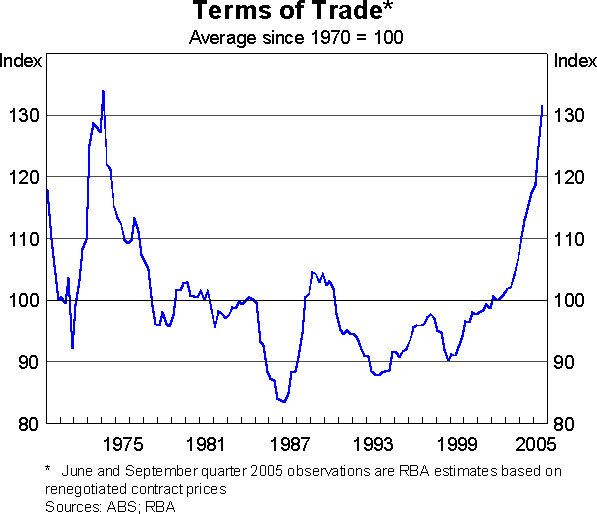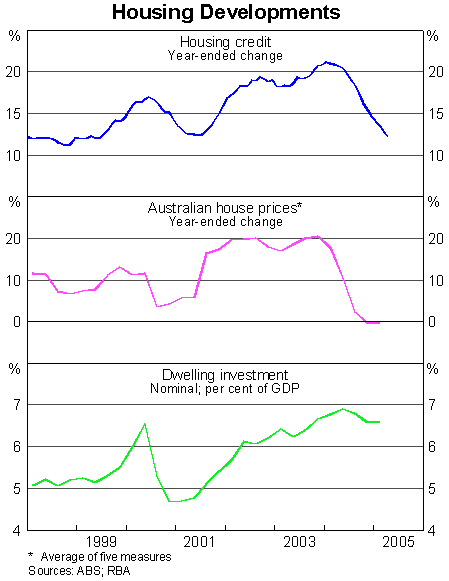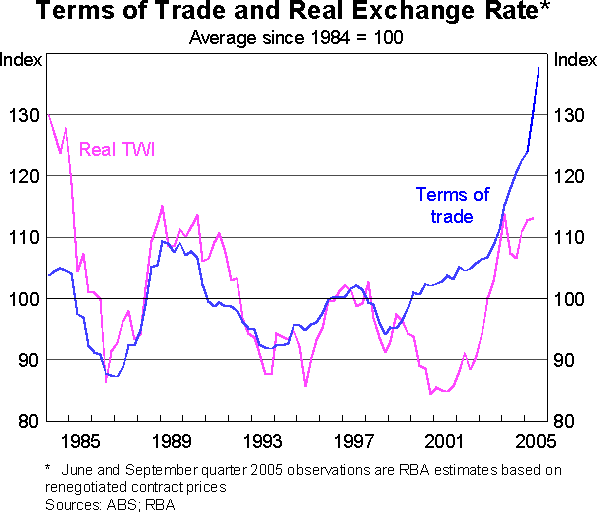Speech Global Influences on the Australian Economy
Let me start by saying what a pleasure it is to be here before such a distinguished gathering at the Australian Institute of Company Directors. I have not spoken on the economy since February, so I will take this opportunity to do so today. My main topic is how global and domestic influences are interacting on the Australian economy. But before doing that I would like to say a few words about monetary policy, in particular how it is formulated.
As readers of the financial press, you will have encountered reports nearly every day of some new economic statistic being released, and some pundit giving an opinion of what this implies for future movements in interest rates. You could be forgiven for thinking that the formulation of monetary policy was simply a matter of collecting the latest month's statistics, weighing them up to see whether they were strong or weak on balance, and then adjusting interest rates accordingly. This very short-term view of monetary policy arises because journalists have to write a story every day and economists in financial institutions have to advise their dealing rooms every day. But monetary policy is a much more slowly evolving process than this, and there are elements in the process that are more important than the evaluation of the latest statistics. The first of these is to have a clearly enunciated framework of what monetary policy is seeking to do, and the second is to have a view of how the world economy is evolving and how it is affecting Australia. Let me now say a little more about each of these subjects.
What can monetary policy achieve?
Views about what monetary policy can and cannot achieve have evolved over the past century or two. The current consensus, based on the experience of the post-war period, is that the principal contribution it can make to economic well-being is to maintain low and stable inflation. As a result, a number of countries, including Australia, have adopted a monetary policy regime based on inflation-targeting. Ours is designed to ensure that the average rate of increase in consumer prices is between 2 and 3 per cent. Note that it is expressed as an average over time; the actual rate does not have to stay between 2 and 3, and in fact it has often been outside that range, though not by much. The centrality of inflation in the monetary policy regime is not because inflation is all we care about. It is there because we believe that low inflation is a necessary condition for sustainable economic growth and good monetary policy is essential to its achievement. The results over the past fourteen years provide evidence in support of this assessment.
It is important to have a framework because there has historically been a temptation to use monetary policy for too many purposes. We still hear calls from time to time to raise interest rates to improve the balance of payments or to stop rising house prices, or, on the other hand, to lower rates because the economy has slowed. In the past, these and other motives often lay behind monetary policy changes, but now it is easier to resist such temptations because they have to be viewed within a more general framework based on their likely implications for future inflation.
The world economy and Australia's place
The second important element is to have a view about how the world economy is evolving and how this will affect Australia. It is fair to say that the major macro-economic events that have affected Australia have to a large extent been imported rather than home-grown. In Australia, the two major economic events of the last century – the Depression of the thirties and the Inflation of the seventies – the world's only peacetime inflation – were both part of worldwide developments. More recently, the international business cycle has been the main determinant of our own; the three most recent Australian recessions of 1974, 1982 and 1990 were part of global recessions. Over this period, we have not had an entirely self-induced recession. Our one significant deviation from the international business cycle is that we did avoid the (admittedly mild) 2001 recession that affected most G7 countries. Similarly, our inflation experience shadowed that of the OECD-area, although we were later than most in bringing it down after the initial surge in the seventies; our good inflation record only dates from the early 1990s.
I think it is true to say that if you wished to forecast the path of the Australian economy, and you were able to have foreknowledge of only one economic variable, the one you would choose would be the path of the world economy. That is not to say that we have no influence over our own destiny – we can make the situation better or worse than it would otherwise be – but we cannot escape the influence of the world business cycle and the other factors that feed off it.
Once the central bank has established what it is trying to achieve with monetary policy and how world events are shaping the direction of the Australian economy, then it is in a position to evaluate the multitude of statistics about the economy that each day brings forth. They essentially indicate whether the ‘big picture’ view of how the economy is evolving is on track or not. Mainly they show whether events are happening quicker or slower than expected, but in extremis, they could mean that the overall assessment was incorrect. There is so much semi-random variability in economic statistics that, unless the underlying processes are known, the statistics alone are unlikely to be able to show where the economy is heading; this is particularly the case if too much emphasis is placed on one month's statistics.
The current situation
I have spoken on several occasions about the risks that can develop as an economic expansion lengthens and economic imbalances emerge. With the Australian economy in the fourteenth year of expansion, we have naturally paid particular attention to these imbalances. The one that was most prominent until recently was the sharp increase in house prices and household debt. More recently, it has been the emergence of capacity constraints in some parts of the economy. No-one should be surprised by this development; it would be remarkable for any economy in the fourteenth year of an expansion if this were not to happen. Finally, we have seen the Australian current account deficit as a per cent of GDP move relatively quickly from its smallest level in twenty years to its largest. These developments are all related, as I hope to show, but I will start my story as usual from the perspective of the world economy.
After the mild recession of 2001, the world economy moved into an expansionary phase, which has been robust overall, but has been marked by very disparate growth rates among major regions. Two regions in particular – Japan and Europe – have made only minimal contributions to the expansion which has been led by the United States, China and other East Asian countries. A notable feature this time is that the rest of the world, which tends to be overlooked in most assessments, has also grown strongly. By the rest of the world, I mean Latin America, India, the Middle East, Eastern Europe, former Soviet Union, etc. Overall, despite these regional divergences, the world economy has expanded at above-average rates over the past few years providing a very favourable backdrop to the Australian economy. Consensus forecasts for 2005 and 2006 are also for above-trend growth, although somewhat lower than last year.
A particular feature of the world economy in this episode is that commodity prices, led by Chinese demand, have risen sharply at a relatively early stage of the global expansion. Apart from oil, the rises have been concentrated in base metals and the two bulk commodities important for Australia – coal and iron ore. As a result, Australia's export prices have received a huge boost. Our terms of trade, which is the ratio of our export prices to our import prices, rose more quickly and to a higher level than anything we had experienced since the early 1970s commodity price boom (Graph 1).

A rise in the terms of trade is an increase in the country's real income. We estimate it has increased our real income by an amount equivalent to about 1½ percentage points of GDP on average in each of the last two years and more is to come.[1] Some of this accrues to workers in the resource sector, some to domestic shareholders and a significant amount through increased taxation and royalties to governments. When the additional income is spent, it provides a significant boost to domestic demand through increased consumption and investment as well as via the government sector, although some flows overseas through imports. In the past, we have sometimes had difficulty in coping with these expansionary effects, as they pushed up inflation and added to the boom and bust character of the Australian economy.
With domestic demand in Australia growing at over 5 per cent in 2002/03 and 2003/04, which is well above long-term potential, and with the economy approaching full capacity in a number of sectors, the extra domestic demand generated by the exceptional rises in the terms of trade could well have had serious inflationary consequences if it had continued. This was particularly so as important prices such as those for oil, steel, plastics, shipping and other inputs to production were rising rapidly around the world. It was these types of concerns that led the Bank to raise interest rates a little further earlier this year.
In the event, the economic situation has evolved quite favourably, with domestic demand continuing to slow to what appears to be a sustainable pace. Output, as measured by GDP, has also slowed and some people are disappointed that GDP growth is now running at a below-average rate, but I view recent events as a healthy correction, and certainly a much better outcome than several other potential outcomes. There are also indications that inflationary pressures are not building as quickly as might have been expected earlier in the year. How has this relatively orderly slowdown come about?
The first reason for the slowing in domestic demand is the change that has occurred in the housing sector. Fuelled by a rapid increase in mortgage lending, house prices rose sharply and house-building activity surged in the first few years of this decade. Over the past year, however, we have had a turnaround in all three; house prices have flattened, mortgage lending has slowed and house-building has contracted modestly (Graph 2). The direct effect of the last-mentioned is the easiest to measure; house-building grew by 11.1 per cent last financial year and has contracted by 5.3 per cent so far this year. This means it added 0.7 per cent to the growth of demand last year and has taken 0.3 per cent off this year. Note, however, that as a per cent of GDP, housing is still high by historical standards.

A second reason for the slowing in domestic demand may be the indirect effects of the change in the housing market. These are harder to measure, but there is some evidence that the flattening of house prices has led households to tighten their belts. Growth in borrowing against housing has slowed to an annualised rate of 10 per cent in the first four months of 2005. While this is well down from a year ago, it is still faster than the growth in household incomes. After several years when borrowing was much higher than housing investment as households withdrew equity to fund consumption, it appears that housing equity withdrawal has now ceased. In line with this, growth in consumption has slowed from 5.9 per cent in 2003/04 to an annual rate of 3.4 per cent so far this year. In other words, while households have stopped adding to their consumption by borrowing against the equity in their houses, there has not been a major scaling back in order to build up savings. It is hard to know whether this household consolidation will continue, for how long it will last, or whether it will intensify. It is early times yet and the situation bears close watching.
As a result of these two influences – the slowing in consumption and the fall in house-building – domestic demand growth has fallen from just over 6 per cent to about 3½ per cent so far this financial year. Business investment continues to grow strongly, which is important given our need to increase capacity, particularly in the exporting sector. Strong employment growth is also underpinning the economic expansion.
Growth of 3½ per cent in domestic demand sounds reasonable, but growth in output, as measured by GDP of only 1.9 per cent over the past year, sounds less satisfactory. What lies behind the lower output growth? The simplest factor to identify is the fall in farm output of 16 per cent. Setting this aside, the growth in non-farm GDP is 2.6 per cent over the past year. But the more interesting story concerns the balance of payments, so I will conclude by saying a few words about our external trade position.
It is well-known that, despite the rise in world prices for our resource exports, Australian exporters have struggled to increase export volumes over recent years. In large part, this is because of the size and speed of the rise in demand coupled with the very limited investment in capacity that has taken place in the late 1990s and early in this decade. This is a worldwide phenomenon; it was because world producers were not able to increase supply to match the increase in demand that world commodity prices increased in the first place. A couple of port bottlenecks in Australia also limited our supply response, but they are not the main part of the story.
At the same time as export volumes remained weak, import volumes over recent years rose strongly. Imports were boosted by the strong domestic demand, partly reflecting the increase in real income due to the terms of trade rise, and by the accompanying rise in the exchange rate. This latter factor, combined with the worldwide fall in the prices of manufactured goods, meant that import prices in Australian dollars fell sharply until recently which encouraged import volumes to rise strongly. This is a normal process whereby a floating exchange rate relieves the pressure on domestic supply and inflation, but at some cost to the balance of payments. The good news is that it does not go on forever. In time, export volumes begin to rise again, as I believe they are now, and the slowing in domestic demand feeds through into slower import growth.
While the rising exchange rate has been an important factor over the past couple of years, if we look at it over the past five years or so, it did not rise as much as would have been expected on the basis of its past relationship with the terms of trade (Graph 3). Interest differentials in Australia's favour also pointed to a larger rise in the exchange rate. This suggests that some other factors must have been at work in the opposite direction, perhaps concern about the weakness in export volumes or broader apprehension about the widening current account deficit itself.

Conclusion
What do we make of all this? The big picture is, I think, that the world business cycle is still at an early stage of expansion, so we can expect continued economic growth over the next few years. This, together with our higher terms of trade and strong investment growth in the presence of some capacity constraints, is exerting an expansionary influence on domestic activity and upward pressure on inflation, mainly at the producer price level, although we also expect consumer price inflation to increase somewhat from its present rate.
At the same time, the economy is at present being affected by some countervailing forces. Consumption has slowed and house-building and farm output are falling; these have exerted a moderating influence and may continue to do so. While there is a natural tendency to be disappointed that the second set of influences is now occurring, the fact is that the economy could not have taken on board the external situation without this moderation in the domestic economy. A failure to slow would most probably have produced the set of economic imbalances, particularly rising inflation, that have ended previous expansions. In this respect, the recent moderation in growth is more likely to prolong the expansion than bring it to an end.
Endnote
This figure is the difference between the growth rates of real GDP and Real Gross Domestic Income for the two years to the March quarter 2005. [1]
